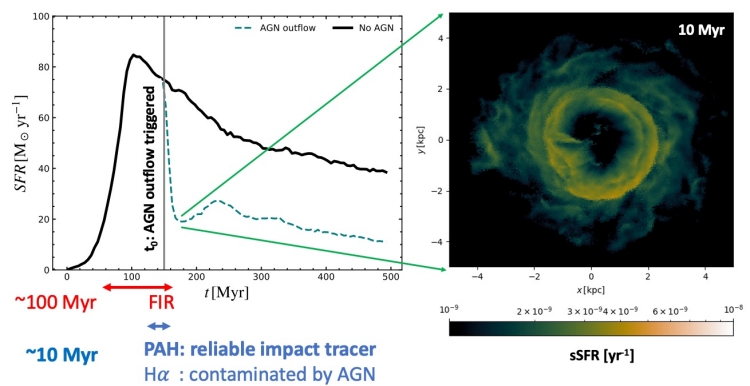Thesis Topic: The impact of multi-phase AGN outflows at the peak epoch of cosmic star- formation
Thesis Supervisor: Vincenzo Mainieri
Abstract
Supermassive black holes (SMBHs) are the perfect candidates to influence the growth and evolution of massive galaxies since they release over their lifetime an energy that is hundreds of times larger than the binding energy of their host galaxies. Such energy, if efficiently coupled with the interstellar medium (ISM) and circum-galactic medium (CGM), could remove, heat or dissociate molecular gas, the fuel of star formation, as well as heat up the galaxy’s halo and suppress further gas accretion. This process is usually referred to as “AGN feedback” and may regulate the rate at which stars can form and ultimately influence the growth of the galaxy. The study of AGN feedback is particularly important at z~2 where the AGN and star-formation activity peak, and it is crucial to explain the local population of massive quiescent galaxies. A possible mechanism for AGN feedback is represented by kpc scales outflows. Understanding the physical properties of these AGN-driven outflows and their ultimate impact on the host galaxies are two major open questions in extra-galactic astronomy.
The proposed PhD thesis aims at addressing two major topics, the multi-gas phase composition of AGN driven outflows and their impact on the host galaxy star-formation, using data from two approved JWST programs (Cycle-1 GO-2177 and Cycle-2 GO-3158) which complements a unique dataset of IFS observations from the ground that we have been building in the past eight years (SUPER: SINFONI and ALMA).

Figure Caption: AGN feedback in hydrodynamical simulations. Left: predicted star formation history in a simulated massive galaxy without (black curve) and with AGN driven outflow (dashed curve) from [8]. There is a significant impact of AGN winds on star-formation, occurring mostly on timescales shorter than ~10 Myr from the initial trigger of the outflow (t0, vertical gray line). Right: slice from the simulation in the left panel showing the specific star-formation rate (sSFR=SFR/Mstar) after 10 Myr from the trigger of an AGN outflow in the center of the galaxy. A rapid decrease in sSFR in the galaxy is the result of the impact of the AGN-driven outflow on the ISM. Observations are fundamental to test this prediction; therefore we need a reliable tracer of recent (<10 Myr) star-formation, such as PAHs, in AGN with known outflows. The approved JWST/MIRI Cycle-2 program used in this PhD project can tackle for the first time this issue at z~2.

